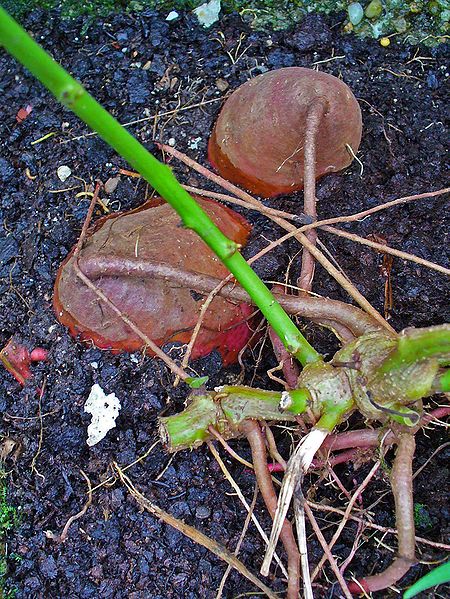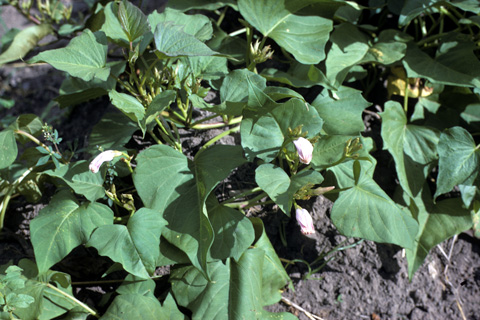
Adaptations of I. batatas!
Root System
 Fibrous roots make up the root system that anchor the plant to the
soil and absorb nutrients and water. Within this root system is an
adaptation that is very special to I. batatas. This adaptation can
be described as thick sections of the plant's roots called storage
roots that allow the plant to store sugars as a form of starch. Storage roots are often times mistaken as
tubers, which are actually swollen stems rather than roots. Being a
cultivated plant, many individuals are planted via stem cuttings. In this case,
swollen storage roots will form off the stem cutting. In other cases
where these plants are grown from true seeds, they exhibit typical root
systems and as the plant grows larger, the central axle will
function as a storage root.
Fibrous roots make up the root system that anchor the plant to the
soil and absorb nutrients and water. Within this root system is an
adaptation that is very special to I. batatas. This adaptation can
be described as thick sections of the plant's roots called storage
roots that allow the plant to store sugars as a form of starch. Storage roots are often times mistaken as
tubers, which are actually swollen stems rather than roots. Being a
cultivated plant, many individuals are planted via stem cuttings. In this case,
swollen storage roots will form off the stem cutting. In other cases
where these plants are grown from true seeds, they exhibit typical root
systems and as the plant grows larger, the central axle will
function as a storage root.
Flowers
 Whether or not a sweet potato plant has the ability to flower
depends on the specific cultivar. Some don't flower at all, some
only have a few flowers, while others flower profusely. If a flower
does exist on the plant, the flower will be bisexual, meaning it can
fertilize itself. An important feature to this adaptation is the
appealing beautiful colors of the flowers. This appearance will
attract organisms such as bees which leads to the spread of the
flower's pollen. One of the many features that flowers contain are
sepals. Sepals enclose and protect the flower during its bud stage.
To learn more about the anatomy of sweet potato flowers, check out
my page on plant
reproduction!
Whether or not a sweet potato plant has the ability to flower
depends on the specific cultivar. Some don't flower at all, some
only have a few flowers, while others flower profusely. If a flower
does exist on the plant, the flower will be bisexual, meaning it can
fertilize itself. An important feature to this adaptation is the
appealing beautiful colors of the flowers. This appearance will
attract organisms such as bees which leads to the spread of the
flower's pollen. One of the many features that flowers contain are
sepals. Sepals enclose and protect the flower during its bud stage.
To learn more about the anatomy of sweet potato flowers, check out
my page on plant
reproduction!
Antibacterial
Adaptation of I. batatas Leaves
 Scientists are starting to accept the sweet potato as
more than just a food source. Certain properties of this plant’s
leaves have proven to be antimicrobial. This was a very exciting
discovery found during a study done by the U.S. Department of
Agriculture in 2007. During 2007 there were huge numbers of
outbreaks of
E. coli,
pathogenic bacteria that cause food poisoning, in the U.S. and
other parts of the world. These breakouts sparked interest in this
experimental study. The study was done to determine the growth
of what kind of bacteria can be inhibited by artificially grown
sweet potato leaves. The results of this experiment left
researchers with the conclusion that sweet potato leaves
definitely do contain antibacterial compounds that are resistant
to
E. coli. In addition, the growth rate of
Staphylococcus aureus,
the species
of bacteria responsible for staph infections, was also greatly reduced
by isolated chemical properties found in sweet potato leaves.
Therefore, these leaves have a promising future of
preventing the growth of bacteria that cause food poisoning in
foods services and could possibly even help in the skin
infections, such as staph infections, with further research.
Scientists are starting to accept the sweet potato as
more than just a food source. Certain properties of this plant’s
leaves have proven to be antimicrobial. This was a very exciting
discovery found during a study done by the U.S. Department of
Agriculture in 2007. During 2007 there were huge numbers of
outbreaks of
E. coli,
pathogenic bacteria that cause food poisoning, in the U.S. and
other parts of the world. These breakouts sparked interest in this
experimental study. The study was done to determine the growth
of what kind of bacteria can be inhibited by artificially grown
sweet potato leaves. The results of this experiment left
researchers with the conclusion that sweet potato leaves
definitely do contain antibacterial compounds that are resistant
to
E. coli. In addition, the growth rate of
Staphylococcus aureus,
the species
of bacteria responsible for staph infections, was also greatly reduced
by isolated chemical properties found in sweet potato leaves.
Therefore, these leaves have a promising future of
preventing the growth of bacteria that cause food poisoning in
foods services and could possibly even help in the skin
infections, such as staph infections, with further research.
More Antibacterial Evidence...
 Supporting the results from the 2007
experiment, the Institute of Chinese Pharmaceutical Sciences
completed a study the following year that tested the antimicrobial
activities of sweet potato storage roots. Plant defensins,
structures found in the DNA, are known to greatly contribute to the
plant’s immune system. The goal of the experiment was
to isolate the specific defensin peptides and test their antifungal
and antibacterial activities. Among the bacteria tested in these
trials was
E. coli. The
results were as expected. A specific defensin, called SPD1, in some
cases reduced the growth in both fungal and bacteria trials by 50%. In conclusion, this defensin is a suitable candidate
for improving plants resistance against microbial diseases and it
also seems to be beneficial for individuals who consume these
storage roots. Research such as the 2007 and 2008
experiments is constantly finding new uses for sweet potatoes in the
botany and medical fields. The possible uses for this super plant
seem to be endless.
Supporting the results from the 2007
experiment, the Institute of Chinese Pharmaceutical Sciences
completed a study the following year that tested the antimicrobial
activities of sweet potato storage roots. Plant defensins,
structures found in the DNA, are known to greatly contribute to the
plant’s immune system. The goal of the experiment was
to isolate the specific defensin peptides and test their antifungal
and antibacterial activities. Among the bacteria tested in these
trials was
E. coli. The
results were as expected. A specific defensin, called SPD1, in some
cases reduced the growth in both fungal and bacteria trials by 50%. In conclusion, this defensin is a suitable candidate
for improving plants resistance against microbial diseases and it
also seems to be beneficial for individuals who consume these
storage roots. Research such as the 2007 and 2008
experiments is constantly finding new uses for sweet potatoes in the
botany and medical fields. The possible uses for this super plant
seem to be endless.
Now that you know a little bit about the sweet potato's sweet adaptations, check out more sweet facts by clicking here!